Table of Contents
James Williams
James WILLIAMS was a musician, and citizen of London.
He is recorded as renting a property in the St. Pancras Soper Lane District between 1747 and 1750, paying yearly 5 pounds and 4 shillings, moving from here some time during 1750 (in which year, paying only 3 pounds and eighteen shillings). The previous resident of this property was John Blackwell (see below), coffee house keeper.


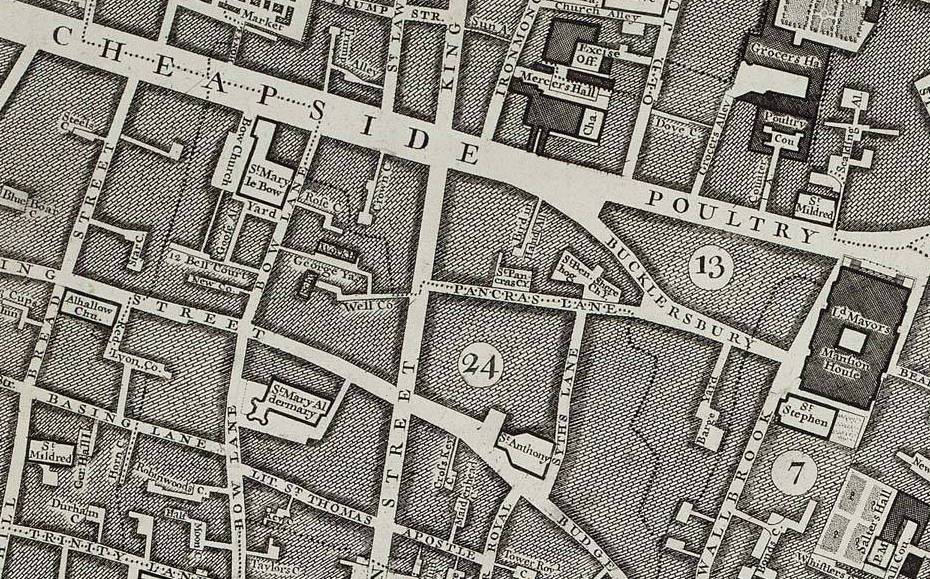
He moved to the Third Precinct area of Aldersgate Street, recorded as 'Over The Way' close to Cradle Court. Available records for this address run from 1751 to 1761.
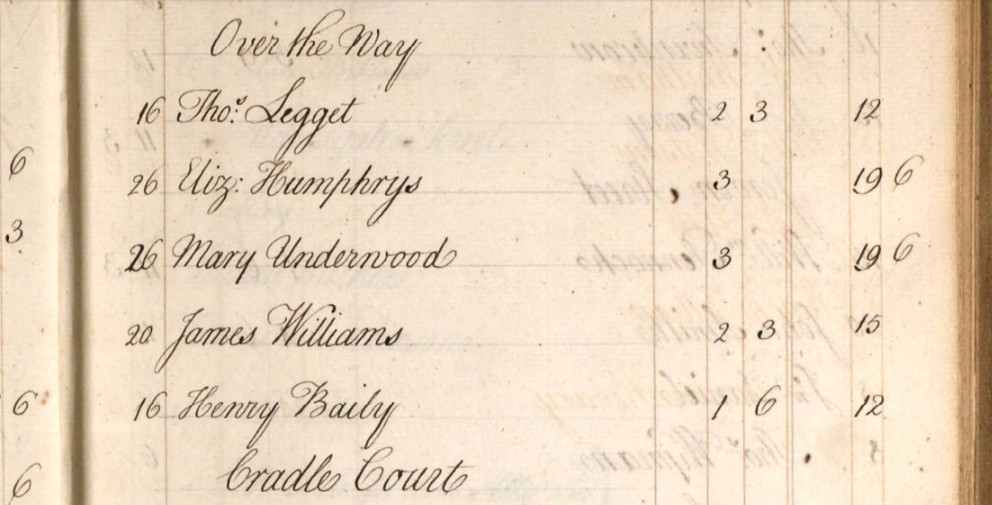
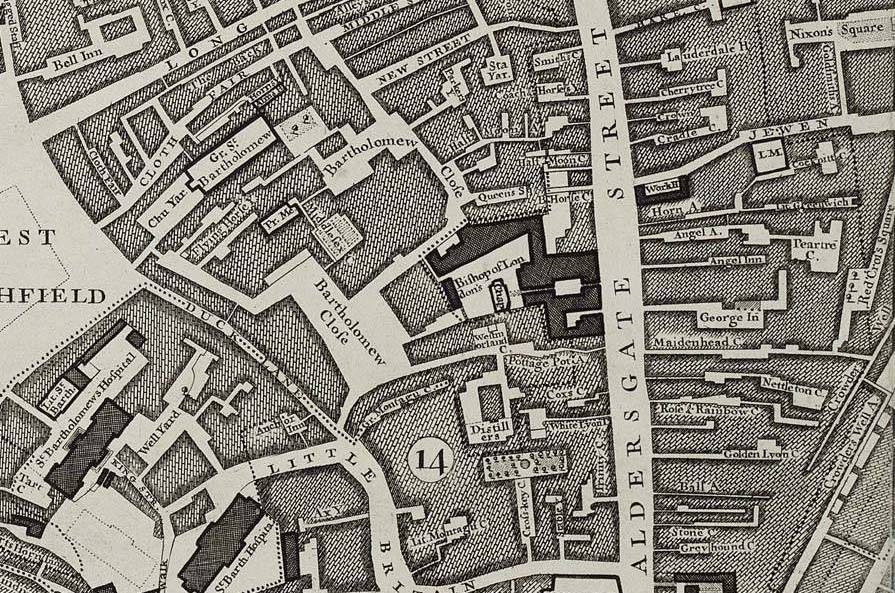
Marriage & Children
He married Mary.
Children of James Williams and Mary:
- James WILLIAMS*, baptised 9 Dec 1744 - St. Thomas the Apostle, London.
- Ann WILLIAMS, baptised 31 May 1747, and buried 24 Jan 1748/49 - St. Mary Le Bow, London.
- Joseph WILLIAMS, baptised 4 Dec 1748 - St. Mary Le Bow, London. »
- Charles WILLIAMS*, baptised 14 Sep 1750 - St. Mary Le Bow, London.
- (Samuel WILLIAMS, baptised 17 Jun 1752 - St Mildred, Poultry, London)
*Note possible burials - St. Mary Le Bow, London.
Charles Williams, 15 May 1764
Mary wife of Jacob Williams, 12 Aug 1774
Jacob Williams, 17 Jul 1777
Jacob Williams, 9 Oct 1786 - aged 33 [1744]
Freedom of the City
8 Apr 1747
In 1746, John Blackwell was recorded as being resident in the property that James Williams took up between 1747 and 1750. According to a witness statement given on 16th April 1740, John Blackwell kept a Coffee-House in Well-Court, in Queen-Street
Well Court and Queen Street today - Northern part of Queen Street was previously Soper Lane.
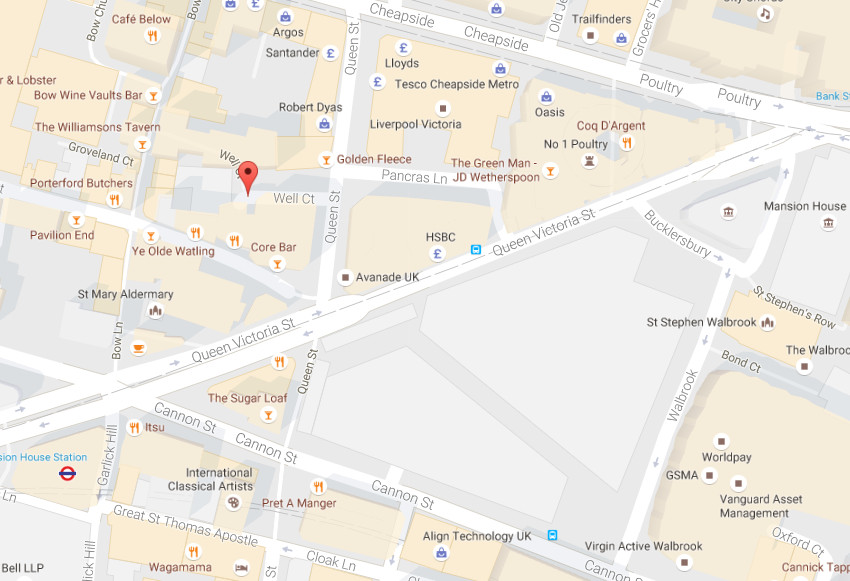
Investigations
Birth Speculations
None of the below is certain, and pure speculation until further facts can be obtained. I am not even able to confirm James was born in London.
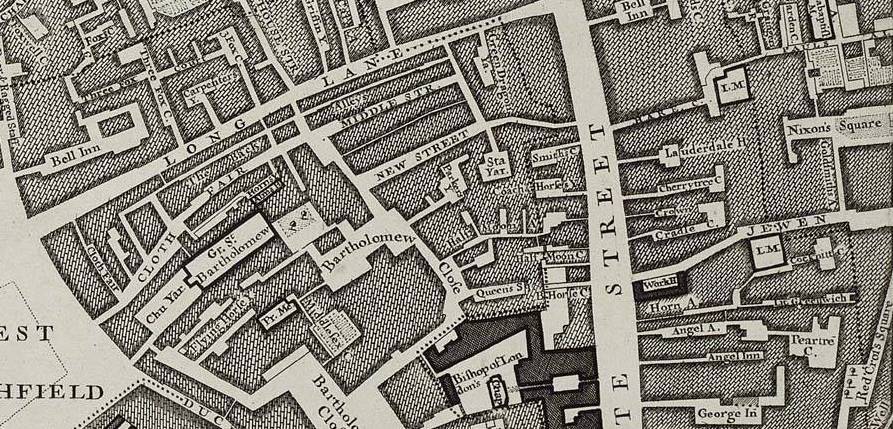
St Bride's, Fleet Street, City of London
8 Dec 1700 - James Williams Widower to Elizabeth Paine Spinster By the Archbishop
James Williams of the parish of St Bartholomew the Great [West Smithfield] London &
Elizabeth Paine of the parish of St Mary Savoy By vertue of the
Arch Bishop Licence He is a Button Feller at the [wheatsheaf inn]
Cloth Faire
St Ann*, Blackfriars, London
4 Jan 1707/08 - James son of James & Elizabeth Williams
*St Ann, Blackfriars, destroyed in the Great Fire of London, 1666, and parish merged with St. Andrew-by-the-Wardrobe.
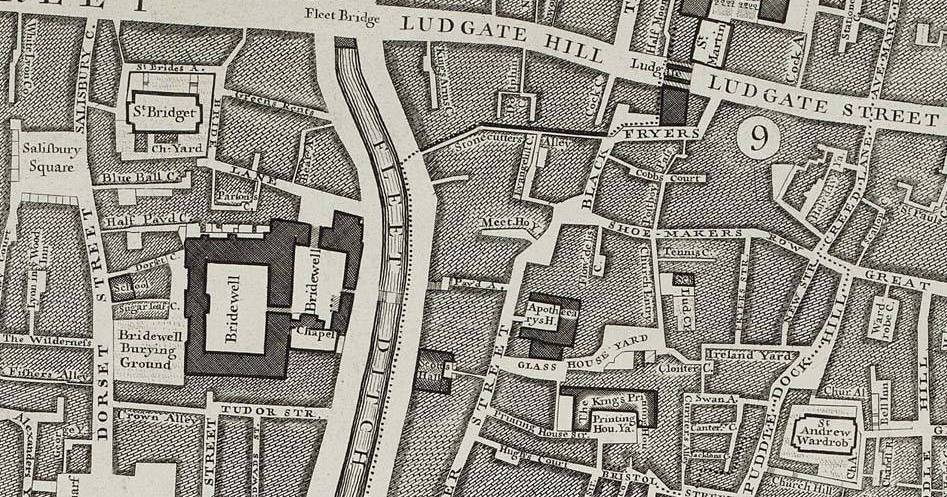
London Land Tax - James Williams
1717 - St Sepulchre, Newgate
City of London, Farringdon Ward Without, Smithfield Precinct
Bansteads Alley*
James Williams
*Adam and Eve Alley on the map
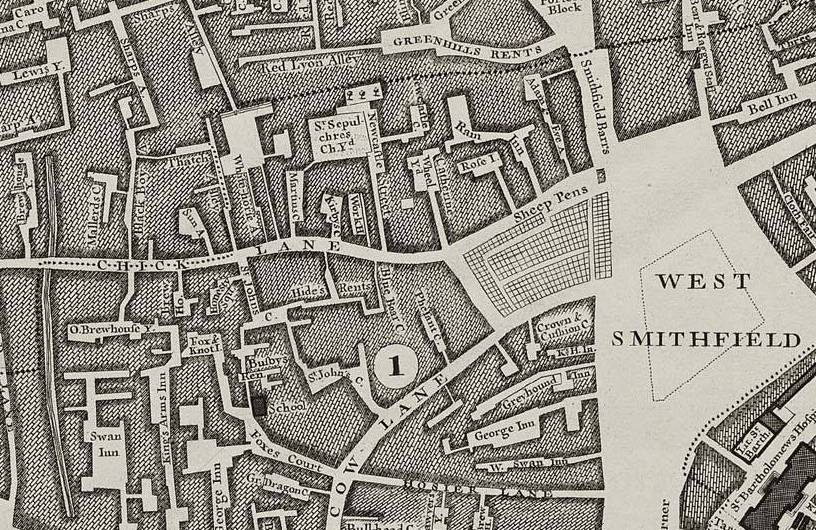
1736 - St Sepulchre, Newgate
City of London, Farringdon Ward Without, Old Bailey Precinct
Turnagain Lane
James Williams
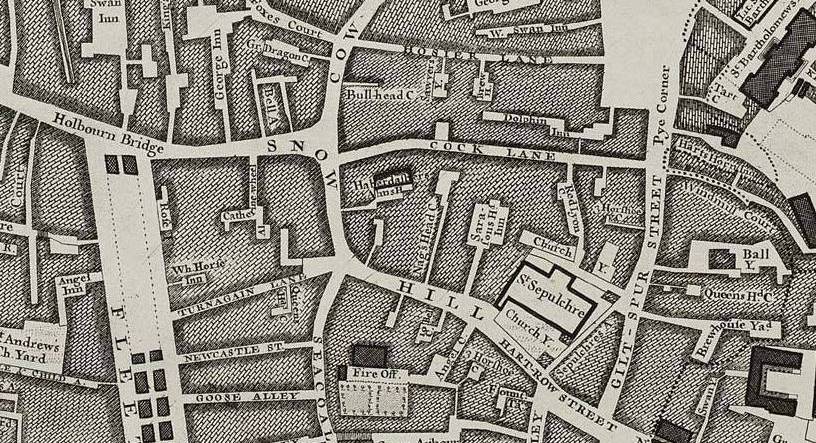
Electoral Registers - James Williams
Name: James Williams
Poll Year: 1710
Company: Drapers
Name: James Williams
Poll Year: 1714
Parish or Rectory: St Pancras
Name: James Williams
Poll Year: 1727
Abode: Budge Row
* Budge Row ran east-west through Cordwainer Street ward. It passed through the ward from Soper Lane in the west to Walbrook in the east. Beyond Soper Lane, Budge Row became Watling Street. Before it came to be known as Budge Row, it once formed part of Watling Street, one of the Roman roads.
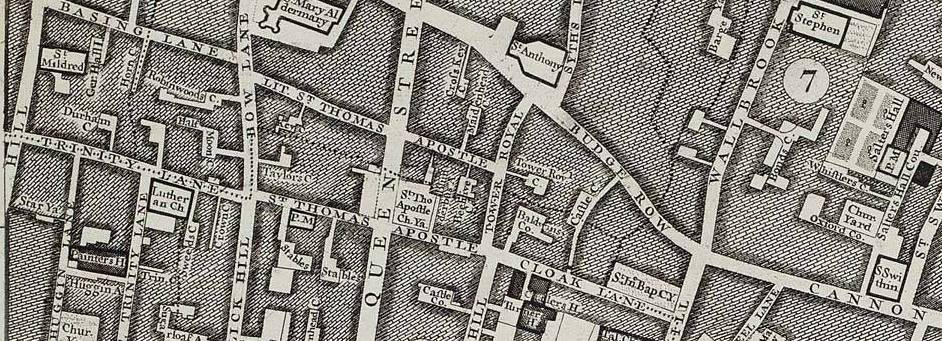
London Land Tax - Joseph Williams
1736 - St Sepulchre, Newgate
Bride Lane » Parsons Court » Street
Joseph Williams » Ditch Side
Court Minute Book form The Musicians' Company Archive
Seemingly this is a James born Nov 1749, after father given the Freedom of the City 25 May 1749. The grandfather was also called James, and a waiter.

The Musicians' Company Archive
The King's Band
British History Online: Musicians 1685–1837
| 1719 | 13 May | Williams, J. |
British History Online: Office-Holders in Modern Britain: Volume 11 (Revised), Court Officers, 1660-1837
Williams, James Musician 13 May 1719 (Lord Chamberlain's Papers 3/63, p. 206; Lord Chamberlain's Papers 3/64, p. 65; Lord Chamberlain's Papers 3/67, p. 40). Last occ. 1779 (Royal Kalendar [1779], p. 73). Vac. by 1780 (Ibid. [1780], p. 73).
From 1719 to the last known reference in 1779 is a total of 60 years - although not knowing how old James was in 1719, I think it can be safely assumed he must have been over 70 by 1779.
| The Royal Kalendar and Court and City Register for England, Scotland, Ireland and the Colonies | |
|---|---|
| 1772 | 1779 |
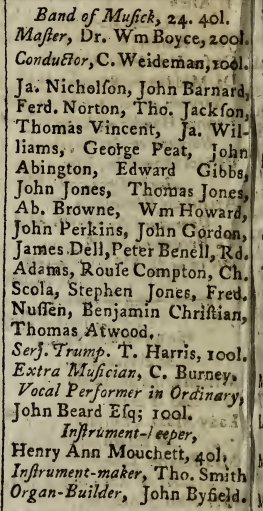 | 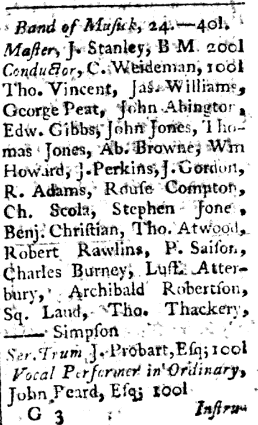 |
Historical Notes:
THE DECLINE OF THE KING'S MUSICK
Shortly after his accession in 1685, James II undertook a reorganization of the King's Musick. What has been an aggregation of separate ensembles and separate payrolls was consolidated into a single ensemble of 31 members under the rubric “Private Music.” Dr. John Blow was the “Composer”; Nicholas Staggins was “master of the Musick”; Henry Purcell played the “harpsicall.” Even under James II, however, the role of the Private Musick was modest. Its members played at the Chapel Royal and also in the short-lived Catholic chapel. The full ensemble, now known as the “King's Band of Musick,” played as a unit primarily in the “court odes” that celebrated the King's and Queen's birthdays, New Year's Day, St. Cecilia's Day, and military victories. Since court duties were relatively light, members of the King's Musick were free to play in the theatres and at concerts, which they did as individuals, not as a group.
With the accession of William and Mary in 1688 the role of the King's Musick was reduced to 24 members, where it remained through most of the eighteenth century. Wages were set at a modest £40 per year, far less than a professional instrumentalist could earn in a theatre orchestra. Another factor in the decline of the King's Musick was the Settlement Act of 1701, which besides settling the royal succession on the House of Hanover, also stipulated that “no person born out of the kingdoms of England, Scotland, or Ireland… shall enjoy any office… either civil or military.” This meant that foreign musicians could no longer serve in the Chapel Royal or the King's Band, not even after they were naturalized as English citizens. The King's Band was thus deprived of the services of some of London's foremost musicians, like the Italian violinists and cellists who came around the turn of the century, of George Frederick Handel, who, thought patronized steadfastly by the Hanoverian kings, was never appointed to any official position.
By the reign of George II (1720-60), the King's Band was playing only about 10 to 15 performances per year: New Year's Day, Twelfth Night, the King's and Queen's birthdays, installations of Knights of the Garter, royal balls, and occasional special events like weddings and funerals. For really festive performances the 24-man orchestra did not suffice and additional instrumentalists were hired, like the “Fifty Seven Supernumerary Performers of Musick” who were engaged to play Handel's anthems at the coronation of George II in 1727. Although the workload was light, an appointment to the King's Band was not a sinecure: all members of the band were professional musicians. The bulk of their musical life, however, took place outside the context of the court. In the theatres or the concert rooms the King's musicians typically played toward the back of their sections, relinquishing the first chairs to younger and to foreign-born instrumentalists.
Taken from The Birth of the Orchestra : History of an Institution, 1650-1815



